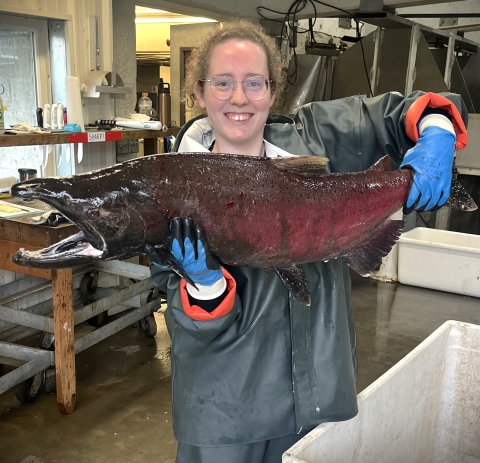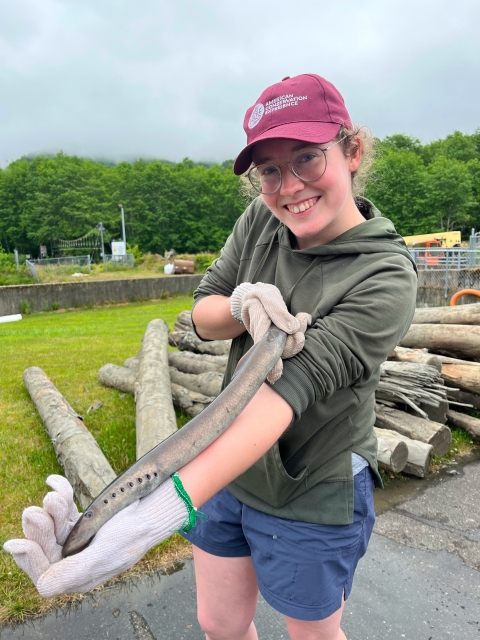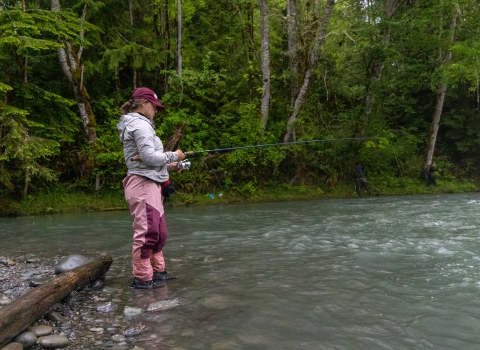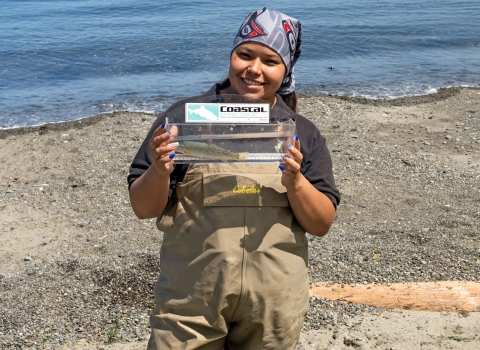By Kathleen Gerard, U.S. Fish & Wildlife Service Intern
Editor's Note: Kathleen Gerard served an 8-month internship with the U.S. Fish & Wildlife Service's Western Washington Fish and Wildlife Conservation office in Lacey, Washington. She also provided valuable support for the Makah, Quilcene, and Quinault National Fish Hatcheries on the Olympic Peninsula as well as a number of conservation partners. Kathleen’s internship was through a partnership with American Conservation Experience. We are thankful for Kathleen's hard work and dedication as well as the support from our partners.
---------
One of my earliest memories handling salmon was volunteering for a broodstock broodstock
The reproductively mature adults in a population that breed (or spawn) and produce more individuals (offspring or progeny).
Learn more about broodstock collection event as a sophomore in college. We were netting adult salmon to hold at the hatchery until eggs were ready to collect and fertilize for next year’s broodstock. My hands were stiff from the frigid air blowing off the river. Despite my effort to layer up, my warmth was fueled by pure excitement. A long gill net was lowered into the river with five students holding the other end of the net, patiently waiting for some action.
In a blink of an eye, I saw a huge male Atlantic salmon swim into the net and barrel roll. I began to pull the net, feeling the weight of the salmon fighting against me. I immediately started untangling that large male. With time against me, I quickly freed the fish’s body leaving only a few inches of net snagged on his sharp teeth and protruding hook nose.
Finally, the fish was free as I carried him into the hatchery where I would assist with spawning these fish in the coming weeks. This was the largest fish that I had ever held. I was covered in fish slime with a big smile on my face, eager to get my hands on another. Little did I know a few years later I would be handling thousands of salmon far from home in the Pacific Northwest.
I remember my first day working at Quinault National Fish Hatchery. Massive coho salmon and winter steelhead were funneled into the facility at a rapid pace. Each person held an important job of sorting fish by species and determining if they were ready to spawn. I enjoyed the adrenaline rush I got from handling hundreds of fish in just a few hours. Each day at the hatchery was hard but rewarding work. By the end of the day, I smelled like a fish and my arms felt sore, but I was excited to do it all over again the next day.
My journey to working in the field of conservation truly started in college. I graduated with a bachelor’s in fisheries management from Lake Superior State University in the Upper Peninsula of Michigan. As an incoming junior, my first job in fisheries was working as a student hatchery technician raising Atlantic salmon. This program offers a unique opportunity for students to gain valuable experience in freshwater aquaculture at a student-run fish hatchery located on the St. Marys River.
In addition to supporting salmon conservation through hatchery work, I assisted U.S Fish and Wildlife Service biologists in the Great Lakes with trapping and removing invasive sea lamprey in the summer and completed a cold-water fish culture internship rearing lake trout in the winter. These opportunities fueled my curiosity of fish ecology and sparked my interest for pursuing a career with the Service.
After graduation, I was eager to expand my knowledge and pursue fisheries research. I was ready for a change. This meant moving across the country to Washington state where I could truly start fresh and dive headfirst into new fishy territory. During my search for job opportunities, I came across an article by Hannah Ferwerda, who wrote about her internship experience with the Service’s Western Washington Fish and Wildlife Conservation Office. I was inspired by how she connected her passion for the outdoors with the opportunity to support a wide range of projects relating to fisheries research. After reading her story, I was hooked to say the least. Lucky for me, there was an internship position advertisement for the same office.
From the first week on the job, my internship was jam-packed with field work. I spent time collecting stomach samples from non-native fishes in an urban lake to better understand the level of predation on juvenile salmon. I learned how to identify the partially digested fish and aquatic invertebrates from those samples under the microscope by examining jaw bones and insect parts. I also tracked radio-tagged adult salmon migrating up the Elwha River.
Toward the end of the internship, I traveled across the Olympic Peninsula to support the Makah, Quilcene, and Quinault National Fish Hatcheries as thousands of steelhead and salmon were returning to spawn. Our crew was responsible for recording species, length, and sex information from tagged fish and collecting the small, coded wire tag which provides age and hatchery information.
While fieldwork, time in the lab, and numerous learning opportunities took up most of my time, I was also able to enjoy the beautiful places that I visited, such as taking long walks on the beach in Neah Bay. There were also plenty of opportunities to learn from the people I was working alongside and talk about their career paths.
Over the last 8 months, I have gained valuable skills while working on a range of fisheries monitoring projects across western Washington. I truly believe my experiences have opened many doors in my pursuit toward a career with the U.S Fish and Wildlife Service.
Soon, I plan to apply for graduate school to explore my research interests further. I hope to one day become a fish biologist so that I can work to conserve and protect our natural resources in Washington.












